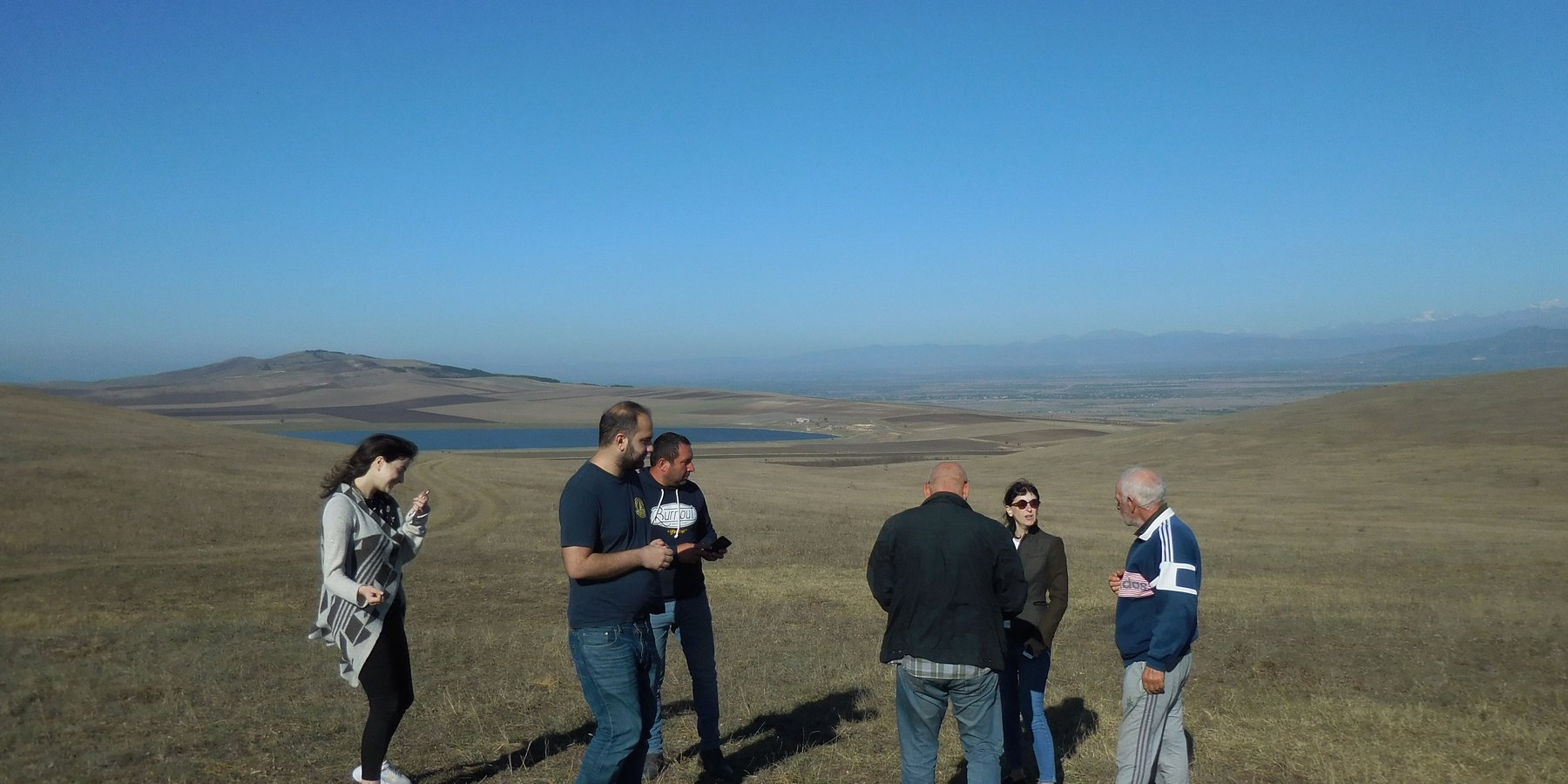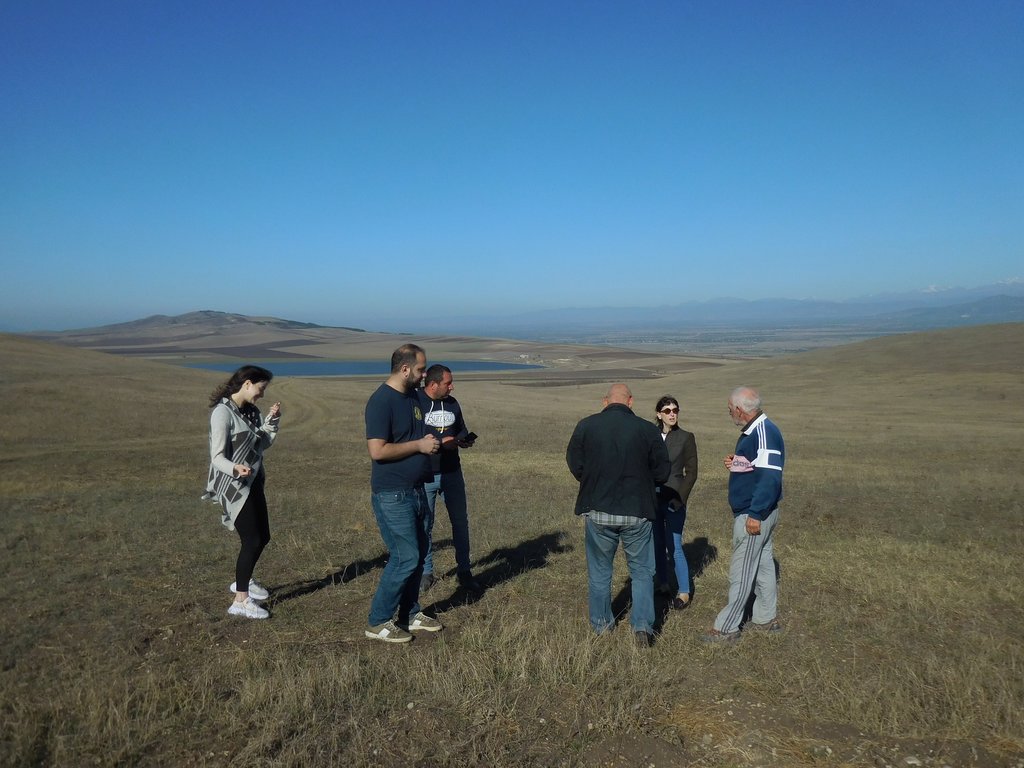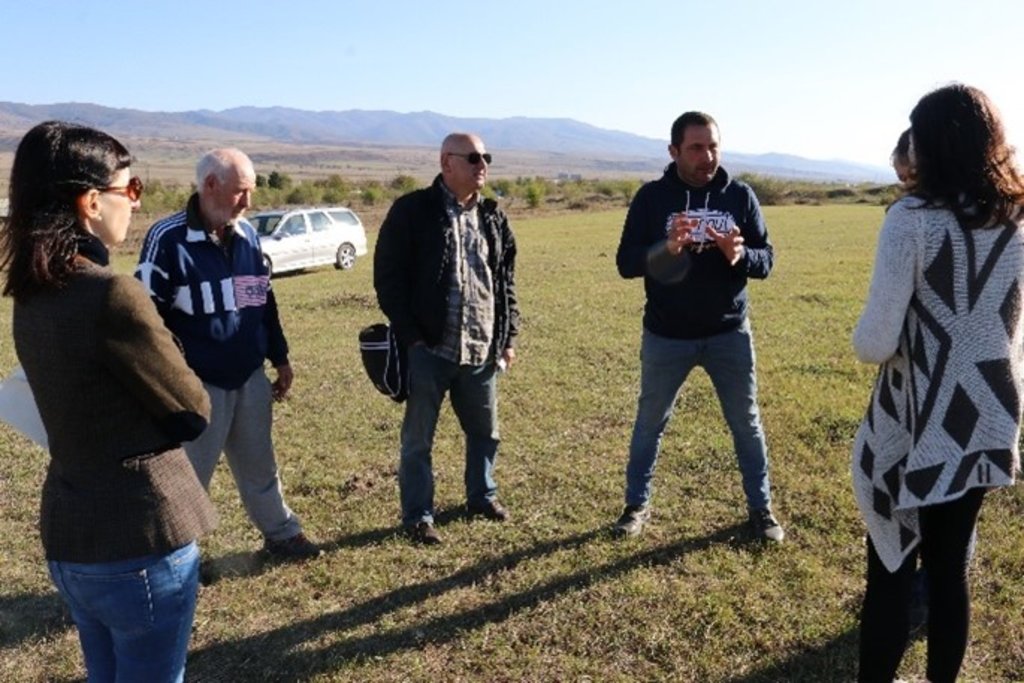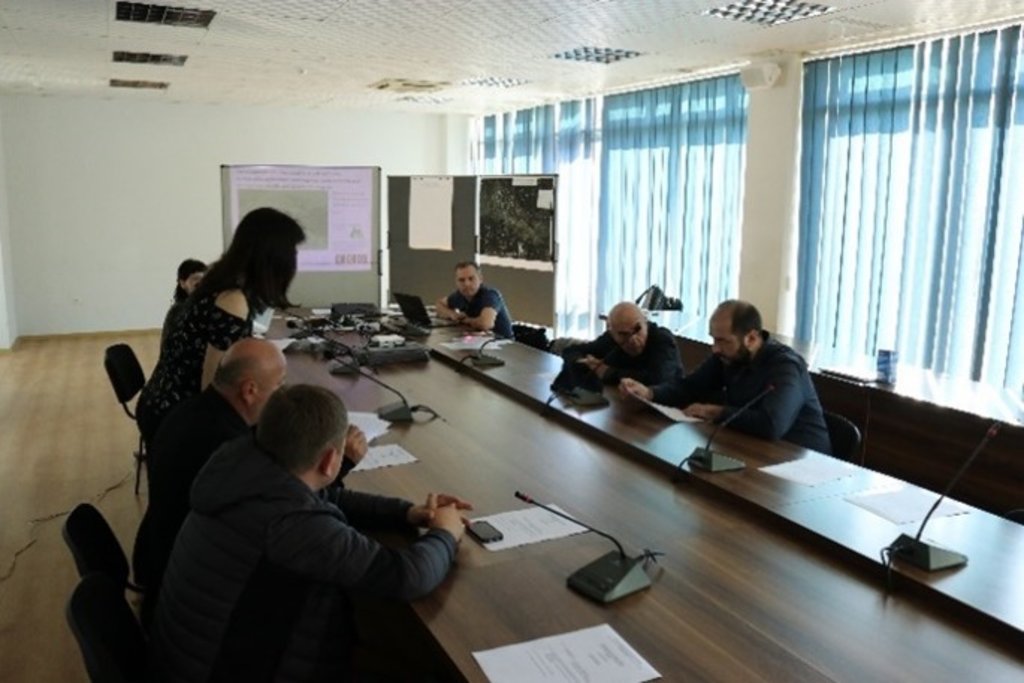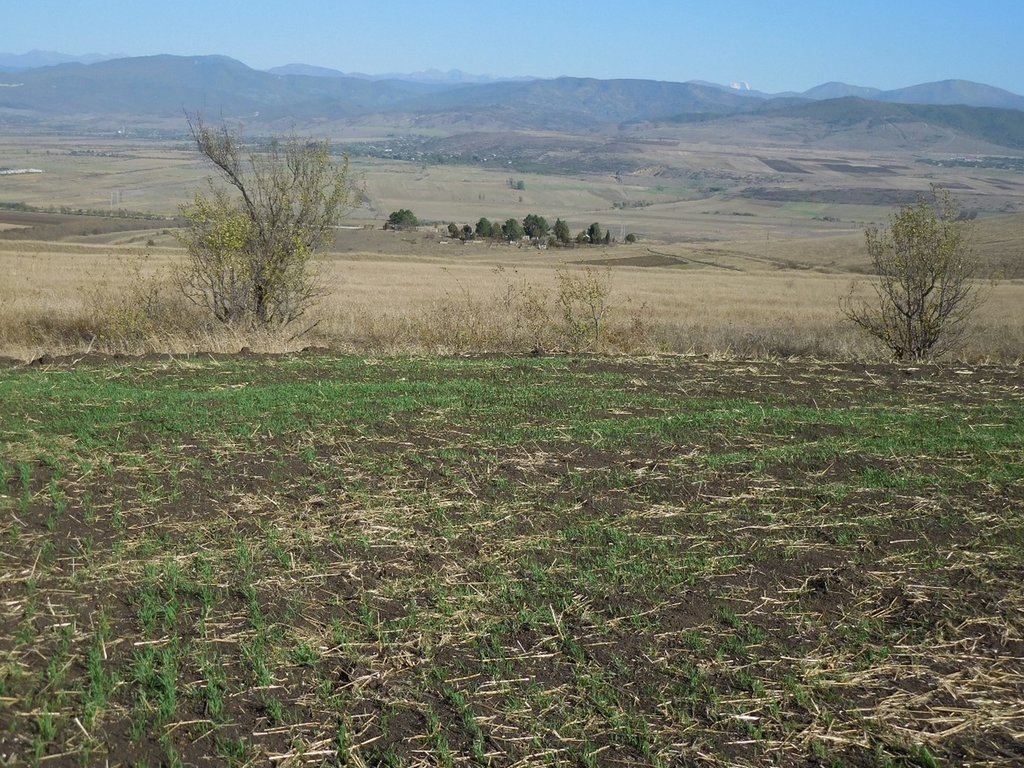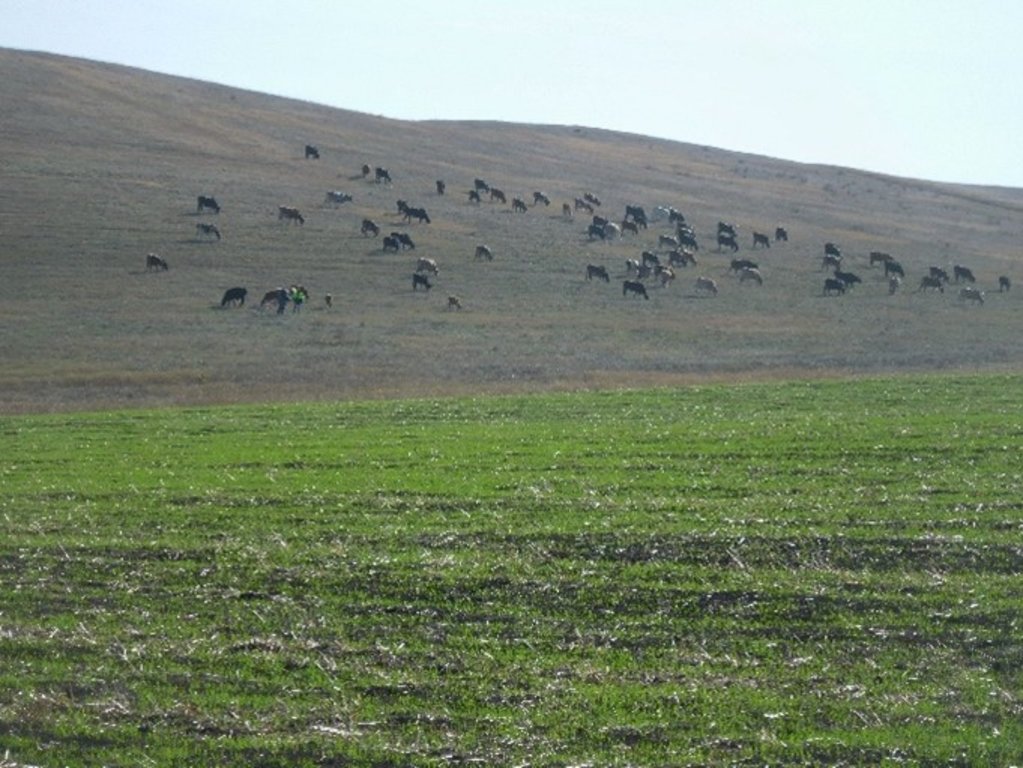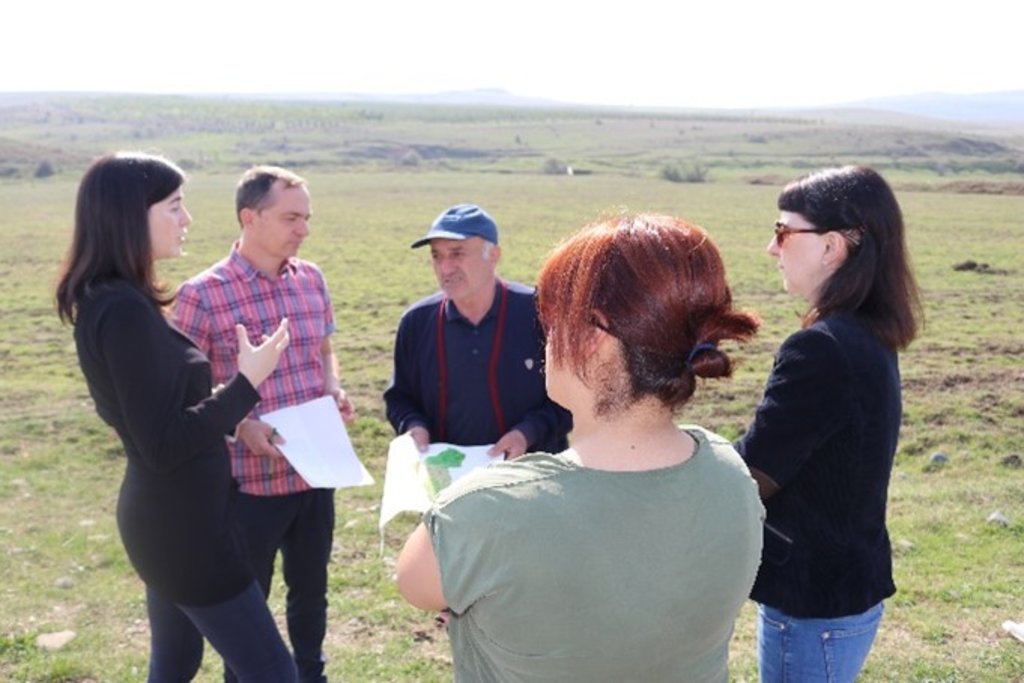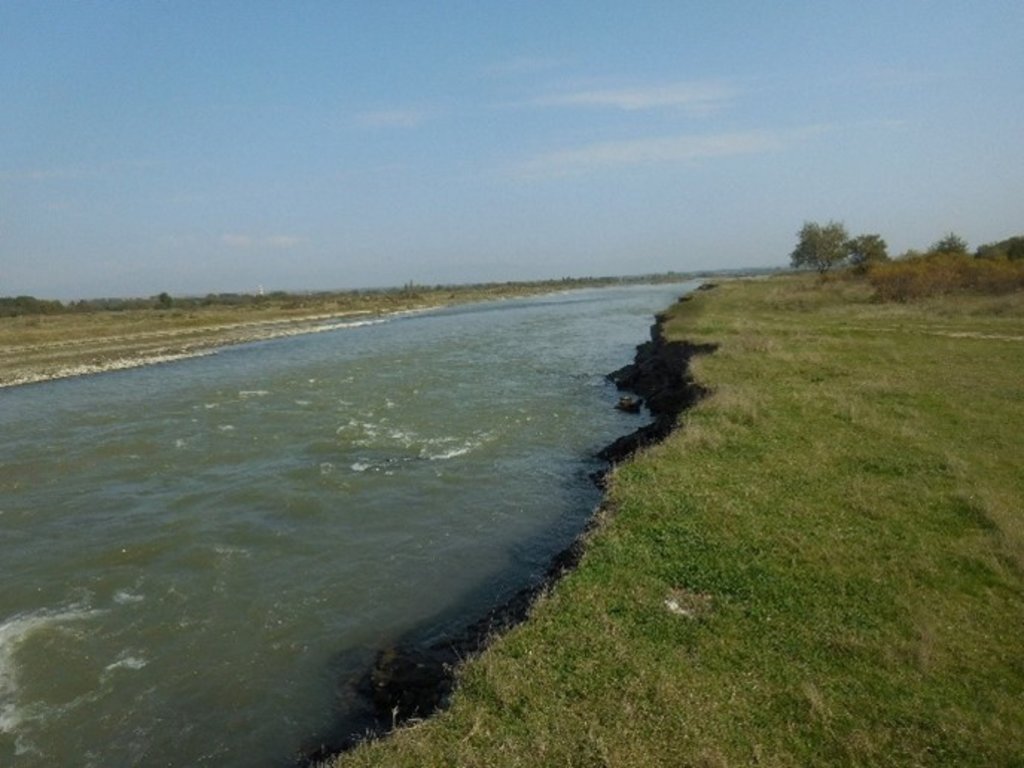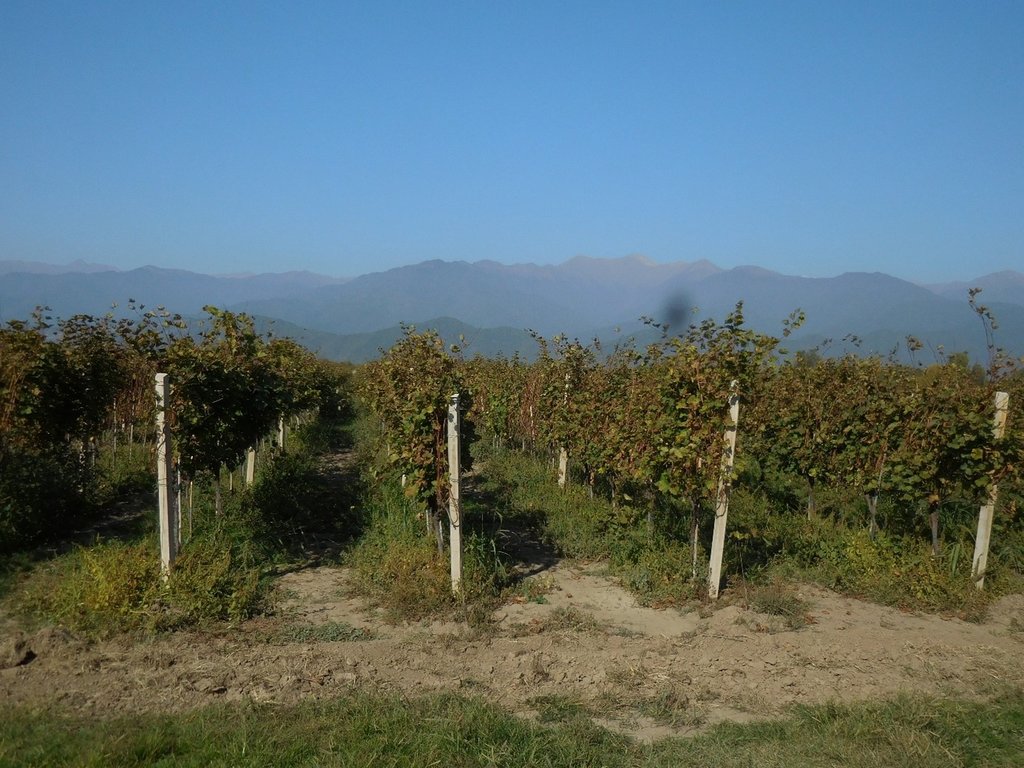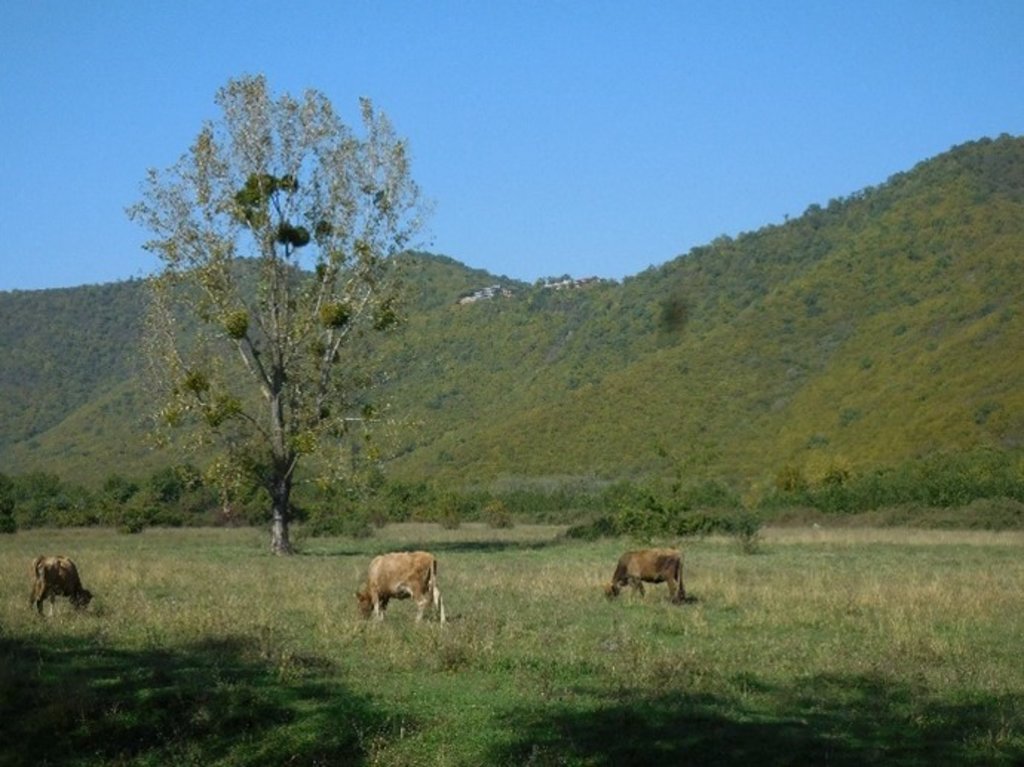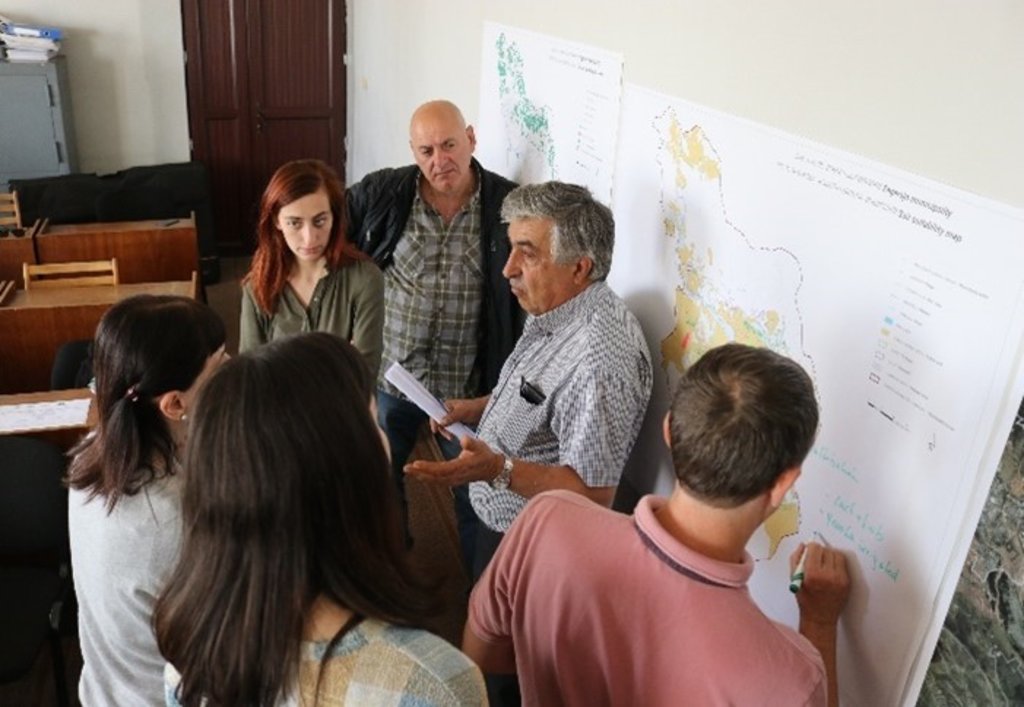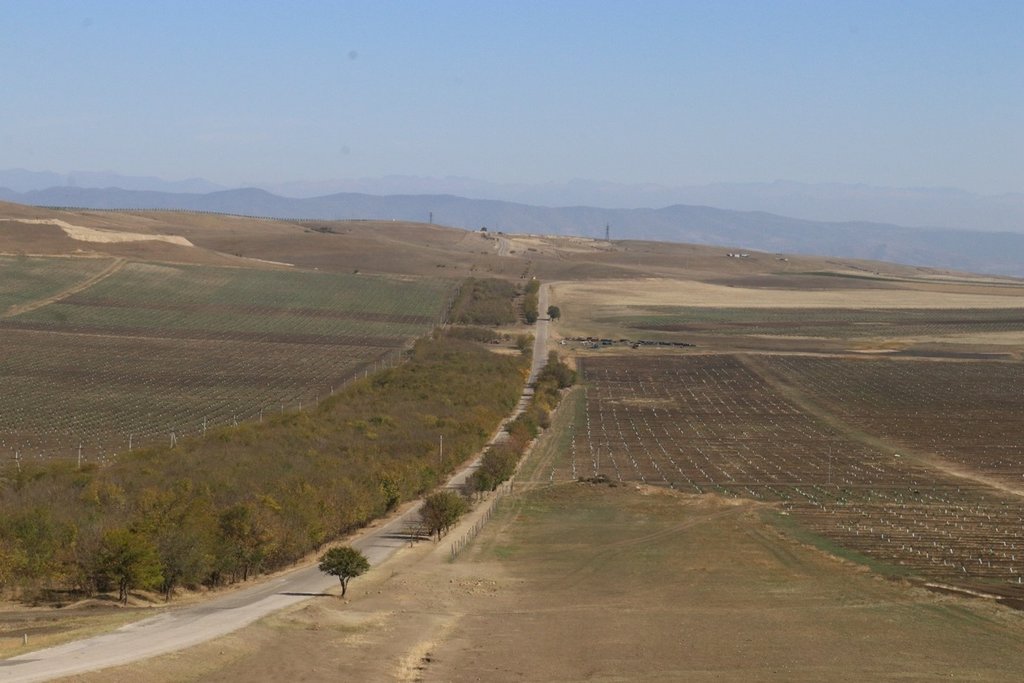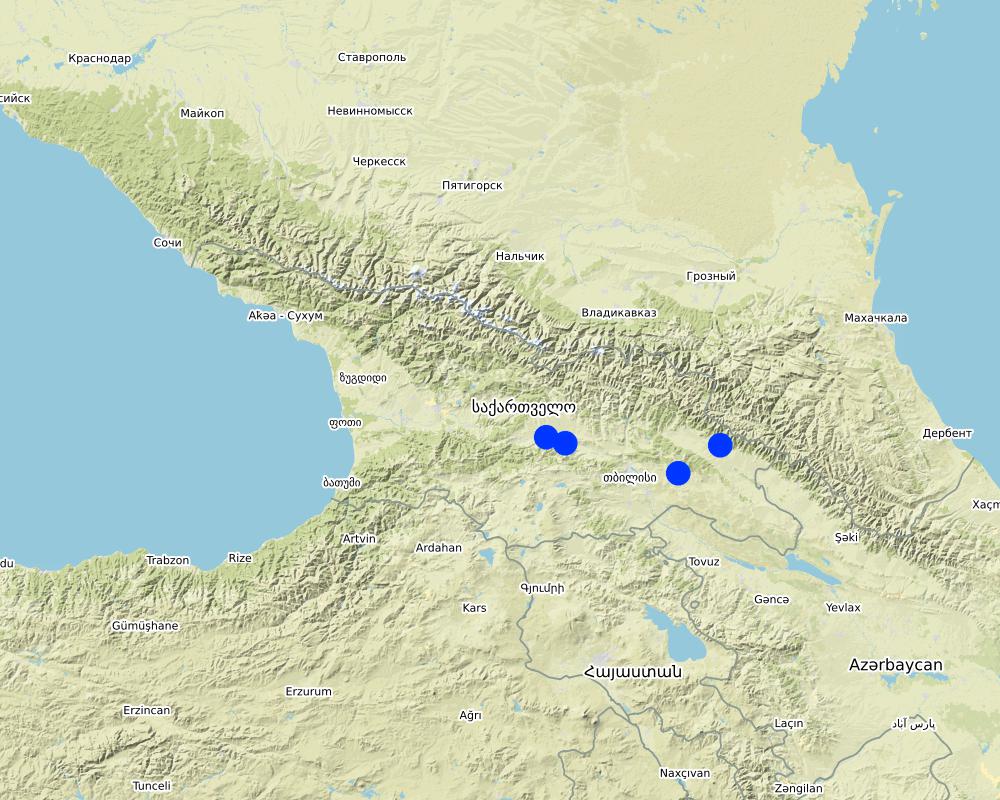Integrated Land Use Plans for Municipalities in Georgia [Géorgie]
- Création :
- Mise à jour :
- Compilateur : Daniel Zollner
- Rédacteurs : Anneliese Fuchs, Michael Huber
- Examinateurs : William Critchley, Rima Mekdaschi Studer
Integrated Land Use Plans for Georgia
approaches_5897 - Géorgie
Voir les sections
Développer tout Réduire tout1. Informations générales
1.2 Coordonnées des personnes-ressources et des institutions impliquées dans l'évaluation et la documentation de l'Approche
Spécialiste GDT:
Zumbulidze Maia
REC Caucasus
13, Badri Shoshitaishvili Street D. Arakishvili 1st dead-end 0179 Tbilisi, Georgia
Géorgie
Spécialiste GDT:
Spécialiste GDT:
Spécialiste GDT:
Nom du projet qui a facilité la documentation/ l'évaluation de l'Approche (si pertinent)
Generating Economic and Environmental Benefits from Sustainable Land Management for Vulnerable Rural Communities of Georgia (GREENLANDS)Nom du ou des institutions qui ont facilité la documentation/ l'évaluation de l'Approche (si pertinent)
Global Environment Facility Georgia (GEF Georgia) - Géorgie1.3 Conditions relatives à l'utilisation par WOCAT des données documentées
Quand les données ont-elles été compilées (sur le terrain)?
14/11/2019
Le compilateur et la(les) personne(s) ressource(s) acceptent les conditions relatives à l'utilisation par WOCAT des données documentées:
Oui
2. Description de l'Approche de GDT
2.1 Courte description de l'Approche
Under the framework of the project ‘Generating Economic and Environmental Benefits from Sustainable Land Management for Vulnerable Rural Communities of Georgia’, four Integrated Land Use Plans (ILUPs) were developed to support sustainable agriculture and rural development in the Georgian municipalities of Gori, Kareli, Kvareli and Sagarejo. The objective of the ILUPs is to provide strategic guidelines for decision makers and authorities for the spatial development of agriculture at the landscape unit level over the period of 2021 to 2030.
2.2 Description détaillée de l'Approche
Description détaillée de l'Approche:
The project ‘Generating Economic and Environmental Benefits from Sustainable Land Management for Vulnerable Rural Communities of Georgia’, financed by the Global Environment Facility (GEF) and implemented by the Regional Environmental Center (REC) for the Caucasus, aims to develop new sustainable land management (SLM) systems at both the commune and farmer plot levels, that integrate climate-smart agricultural production, food security and resilience and thereby contribute to Georgia’s objectives for Land Degradation Neutrality.
This WOCAT-based approach describes the development of four Integrated Land Use Plans (ILUPs) for sustainable agriculture and rural development in the municipalities of Gori, Kareli, Kvareli and Sagarejo (each 1000-2500km2).
The objective of the ILUPs is to provide strategic guidelines for decision makers and authorities for the spatial development of agriculture in the four municipalities for the period from 2021 to 2030 at the landscape level. This takes into consideration the balance of nature and human needs, and integrates different sectors and perspectives in the plan. This is to create synergies on the one hand, and to avoid conflicting goals on the other. Special attention is paid to the complex interactions between agriculture, climate change and land degradation. Thus, the ILUPs aim to develop and strengthen Sustainable Land Management (SLM) practices, Climate Smart Agriculture (CSA) and Land Degradation Neutrality (LDN) and to provide different options for further development. Above all, the plans aim to bring together relevant aspects from existing strategies and policies with local needs and ideas and link them at the spatial level as far as possible.
The ILUP project was implemented between the years 2019 and 2021. The development of the plan needs different approaches and methods - including literature research, statistical data evaluation, field mission, GIS analysis, and suitability assessment. With inception and field visits, workshops with the municipal LDN working group, interviews with farmers, and analyses of different base maps, the land use, the suitability for their development options, and the degradation risks of the area were identified and reflected step by step. The intersection and aggregation of the data led to the definition of the following main basic functional units:
- High Production Value (HPV) Farmland (for perennials, annual cropland and grassland)
- High Nature Value (HNV) Farmland
- High Social Value (HSV) Farmland and, as a specific output,
- Hot Spots of degradation (water erosion, wind erosion, and salinization).
The results were documented in a sectoral, technical plan for each municipality. The ILUP is intended to serve as a basis for further planning, capacity building and decision making procedures within the framework of legal responsibilities and requirements (e. g. for the municipal spatial plan). A second document (also recorded under WOCAT) is based on the outcome of this showcase and predominantly focuses on LDN implementation options by the application and adoption of various SLM and CSA practices.
2.3 Photos de l'approche
2.5 Pays/ région/ lieux où l'Approche a été appliquée
Pays:
Géorgie
Région/ Etat/ Province:
Shida Kartli and Kakheti
Autres spécifications du lieu :
Gori, Kareli, Kvareli, Sagarejo
Commentaires:
The points are located within the four municipalities of Gori, Kareli, Kvareli and Sagarejo. The land use plan was prepared for the entire territory of the four municipalities.
Map
×2.6 Dates de début et de fin de l'Approche
Indiquez l'année de démarrage:
2019
Date (année) de fin de l'Approche (si l'Approche n'est plus appliquée):
2021
Commentaires:
ILUPs as basic planning documents were finished in June 2021. However, there is a next phase needed in order to include local stakeholders, national experts and farmers more intensively for implementation on plot level.
2.7 Type d'Approche
- fondé sur un projet/ programme
2.8 Principaux objectifs de l'Approche
The objective of the ILUPs is to provide strategic guidelines for decision makers and authorities for the spatial development of sustainable agriculture in the four municipalities for the period from 2021 to 2030 at the landscape level. It takes into consideration the balance of nature and human needs and integrates different sectors and perspectives in the plan. This is to create synergies on the one hand and to avoid conflicting goals on the other.
2.9 Conditions favorisant ou entravant la mise en œuvre de la(des) Technologie(s) appliquée(s) sous l'Approche
normes et valeurs sociales/ culturelles/ religieuses
- favorise
basically, awareness of the necessity to use the land in a sustainable manner exists
- entrave
historically conditioned reservation
disponibilité/ accès aux ressources et services financiers
- favorise
a few international financing tools are existing (GEF, GCF, etc)
- entrave
holistic, transsectoral, and adaptive financing mechanisms restricted
cadre institutionnel
- favorise
agricultural experts at the local level
- entrave
lack of education possibilities
collaboration/ coordination des acteurs
- favorise
- permanent working groups existing (LDN working groups, ministerial working groups etc.)
- active actors in the region
- entrave
continuing lack of cooperation
cadre juridique (régime foncier, droits d'utilisation des terres et de l'eau)
- favorise
legal framework has been established recently
- entrave
lack of land registration
cadre politique
- favorise
abundant framework documents existing
- entrave
implementation of the policies is the challenge
gouvernance foncière (prise de décisions, mise en œuvre et application des décisions)
- favorise
recently re-structured administrative entities (is a potential in the long run)
- entrave
recently re-structured administrative entities (phase of change)
connaissances sur la GDT, accès aux supports techniques
- favorise
national service provider existing
- entrave
lack of knowldege and capacity
marchés (pour acheter les intrants, vendre les produits) et prix
- favorise
adjacent urban areas
- entrave
- high economic pressure on the world market
- low income level in the regions
charge de travail, disponibilité de la main-d'œuvre
- entrave
demographic change
3. Participation et rôles des parties prenantes impliquées dans l'Approche
3.1 Parties prenantes impliquées dans l'Approche et rôles
- exploitants locaux des terres / communautés locales
various farmers
visits to the fields with the local farmers, discussions about the type of cultivation, specific needs and ideas
- chercheurs
Tbilisi State University
Scientific expertise on land use and soil productivity
- ONG
REC Caucasus
Supervisors, consultants, GIS analyses, participation in the LDN Working Group Meeting
- gouvernement local
- Executive Office of the Gori Municipal Council
- City Hall (formerly Municipal Administration“Gamgeoba”), Municipality of Gori
- City Hall (formerly Municipal Administration“Gamgeoba”), Municipality of Kareli
- City Hall (formerly Municipal Administration“Gamgeoba”), Municipality of Kvareli
- City Hall (formerly Municipal Administration“Gamgeoba”), Municipality of Sagarejo
Participation in the LDN Working Group Meeting
- gouvernement national (planificateurs, décideurs)
- Ministry of Environmental Protection and Agriculture of Georgia (MEPA)
- Agricultural and Rural Development Agency (ARDA)
Participation in the LDN Working Group Meeting, process steering and embedment into national policies
- organisation internationale
UNEP
Steering of the whole GEF project (with the ILUPs as one component of it)
3.2 Participation des exploitants locaux des terres/ communautés locales aux différentes phases de l'Approche
| Participation des exploitants locaux des terres/ communautés locales | Spécifiez qui était impliqué et décrivez les activités | |
|---|---|---|
| initiation/ motivation | aucun | |
| planification | passive | Local land users were consulted to gain experience and insight into the situation of agriculture in the different areas. The interviews were then incorporated into the preparation of the maps and land use plans. |
| mise en œuvre | interactive | - during the inception mission - in the course of the interactive ILUP workshops |
| suivi/ évaluation | soutien extérieur | - supervision and critical reflection by experts and the client - presentation and reflection at the GEF project steering commitee meeting (about 30 persons - decision makers from different policy levels, national and international experts, project manager etc.) |
3.4 Prises de décision pour la sélection de la Technologie/ des Technologies
Indiquez qui a décidé de la sélection de la Technologie/ des Technologies à mettre en œuvre:
- principalement les spécialistes de la GDT, après consultation des exploitants des terres
Expliquez:
The ILUP provides several options to use SLM technologies: the final decision will take place in a next step. Some specific technologies and actions (no-tillage, windbreaks..) are currently implemented.
4. Soutien technique, renforcement des capacités et gestion des connaissances
4.1 Renforcement des capacités/ formation
Une formation a-t-elle été dispensée aux exploitants des terres/ autres parties prenantes?
Non
4.2 Service de conseils
Les exploitants des terres ont-ils accès à un service de conseils?
Non
4.3 Renforcement des institutions (développement organisationnel)
Des institutions ont elles été mises en place ou renforcées par le biais de l'Approche?
- oui, modérément
Spécifiez à quel(s) niveau(x), ces institutions ont été renforcées ou mises en place:
- local
Décrivez l'institution, ses rôles et responsabilités, ses membres, etc.
Representatives of the municipalities - regional expertise, practical implementation, embedded into local policies.
Précisez le type de soutien:
- renforcement des capacités/ formation
Donnez plus de détails:
Discussions and workshops to contribute to a better common understanding and transsectoral learning from each other.
4.4 Suivi et évaluation
Le suivi et l'évaluation font ils partie de l'Approche? :
Non
4.5 Recherche
La recherche a-t-elle fait partie intégrante de l’Approche?
Non
5. Financement et soutien matériel externe
5.1 Budget annuel de la composante GDT de l'Approche
Si le budget annuel précis n'est pas connu, indiquez une fourchette:
- 10 000-100 000
Commentez (par ex. principales sources de financement/ principaux bailleurs de fonds):
Global Environmental Facility (GEF), in the frame of the project: Generating Economic and Environmental Benefits from Sustainable Land Management for Vulnerable Rural Communities of Georgia
5.2 Soutiens financiers/ matériels fournis aux exploitants des terres
Les exploitants des terres ont-ils reçu un soutien financier/ matériel pour la mise en œuvre de la Technologie/ des Technologies?
Oui
Si oui, spécifiez le(s) type(s) de soutien, les conditions et les fournisseurs:
Different sources and options of support are recommended in the ILUPS, but needs to be decided.
5.4 Crédits
Des crédits ont-ils été alloués à travers l'Approche pour les activités de GDT?
Non
5.5 Autres incitations ou instruments
D'autres incitations ou instruments ont-ils été utilisés pour promouvoir la mise en œuvre des Technologies de GDT?
Non
6. Analyses d'impact et conclusions
6.1 Impacts de l'Approche
Est-ce que l'Approche a autonomisé les exploitants locaux des terres, amélioré la participation des parties prenantes?
- Non
- Oui, un peu
- Oui, modérément
- Oui, beaucoup
- integration of local decision maker was core part of the planning procedure - more empowerment of land users planned for the detailed planning phase
Est-ce que l'Approche a aidé les exploitants des terres à mettre en œuvre et entretenir les Technologies de GDT?
- Non
- Oui, un peu
- Oui, modérément
- Oui, beaucoup
The ILUP is designed to be the fundamental basis for any kind of SLM technologies
Est-ce que l'Approche a amélioré la coordination et la mise en œuvre de la GDT selon un bon rapport coût-efficacité?
- Non
- Oui, un peu
- Oui, modérément
- Oui, beaucoup
The whole plan is dedicated to coordinate approaches and implementations
Est-ce que l'Approche a amélioré les connaissances et les capacités des exploitants des terres pour mettre en œuvre la GDT?
- Non
- Oui, un peu
- Oui, modérément
- Oui, beaucoup
Little in the process of elaboration, but will improve significantly in the course of implementation
Est-ce que l'Approche a amélioré les connaissances et les capacités des autres parties prenantes?
- Non
- Oui, un peu
- Oui, modérément
- Oui, beaucoup
Little in the process of elaboration, but will improve significantly in the course of implementation
Est-ce que l'Approche a atténué les conflits?
- Non
- Oui, un peu
- Oui, modérément
- Oui, beaucoup
The whole plan is designed to mitigate land use conflicts
Est-ce que l'Approche a autonomisé les groupes socialement et économiquement défavorisés?
- Non
- Oui, un peu
- Oui, modérément
- Oui, beaucoup
A large proportion of the approach is dedicated to small farmers
Est-ce que l'Approche a amélioré l'égalité entre hommes et femmes et autonomisé les femmes et les filles?
- Non
- Oui, un peu
- Oui, modérément
- Oui, beaucoup
The gender aspect is integrated into the plan, but needs implementation
Est-ce que l'Approche a amélioré les questions foncières et des droits d'utilisation qui entravent la mise en œuvre des Technologies?
- Non
- Oui, un peu
- Oui, modérément
- Oui, beaucoup
The approach underlined the necessity of land registration
The plan is designed to improve food security
The plan is designed to improve the development of new markets resp. the access of existing markets
Est-ce que l'Approche a conduit à l'utilisation/ sources d'énergie plus durables?
- Non
- Oui, un peu
- Oui, modérément
- Oui, beaucoup
Some components are dealing with energy topics.
Est-ce que l'Approche a amélioré la capacité des exploitants des terres à s'adapter aux changements/ extrêmes climatiques et a atténué les catastrophes liées au climat?
- Non
- Oui, un peu
- Oui, modérément
- Oui, beaucoup
Little in the process of elaboration, but will improve significantly in the course of implementation
Est-ce que l'Approche a conduit à des emplois, des opportunités de revenus?
- Non
- Oui, un peu
- Oui, modérément
- Oui, beaucoup
Little in the process of elaboration, but should improve significantly in the course of implementation
6.2 Principale motivation des exploitants des terres pour mettre en œuvre la GDT
- augmenter la production
- augmenter la rentabilité/ bénéfice, rapport coûts-bénéfices
- réduire la dégradation des terres
- réduire les risques de catastrophe
- conscience environnementale
- améliorer les connaissances et compétences en GDT
- atténuer les conflits
6.3 Durabilité des activités de l'Approche
Les exploitants des terres peuvent-ils poursuivre ce qui a été mis en œuvre par le biais de l'Approche (sans soutien extérieur)?
- non
Si non ou incertain, spécifiez et commentez:
The approach needs embedding into local governance structures
6.4 Points forts/ avantages de l'Approche
| Points forts/ avantages/ possibilités du point de vue de l'exploitant des terres |
|---|
| clear overview of land suitability |
| diversification options |
| set of proposed measures and actions |
| Points forts/ avantages/ possibilités du point de vue du compilateur ou d'une autre personne ressource clé |
|---|
| fundamental for strategic and coordinated development, practical framework for implementation |
| stringent target system, compiled at different levels |
| integrated development approach, combining all dimensions of sustainability |
| core tool to adapt to and mitigate climate change |
6.5 Faiblesses/ inconvénients de l'Approche et moyens de les surmonter
| Faiblesses/ inconvénients/ risques du point de vue de l’exploitant des terres | Comment peuvent-ils être surmontés? |
|---|---|
| plan might raise expectations and an "atmosphere of departure", that cannot be fullfilled in due time |
- consistent and timely implementation of proposed measures - acquisition of financial resources - strengthening local structures and participation |
| plan will not enter next phases, thus implementation might get stuck and/or will not meet the needs on plot level fully | Consistent and timely implementation of the proposed next steps (review process, detailed planning, embedding into municipal land use planning system) |
| Faiblesses/ inconvénients/ risques du point de vue du compilateur ou d'une autre personne ressource clé | Comment peuvent-ils être surmontés? |
|---|---|
| Risk that further planning process gets stuck and/or lacks participation |
- intensive land user involvement - cross-sectoral participation - detailed (process) planning (at plot level) |
| Risk of weak implementation because of lack of framework conditions |
- further land registration needed - detailed planning needed (next phase) - according financing mechanisms needed - embedding into communal planning environment |
7. Références et liens
7.1 Méthodes/ sources d'information
- visites de terrain, enquêtes sur le terrain
4 local workshops
- interviews/entretiens avec les exploitants des terres
about 5 interviews
- interviews/ entretiens avec les spécialistes/ experts de GDT
- one scientific expert
- several representatives from the steering commitee of the project
- compilation à partir de rapports et d'autres documents existants
About 50 reports and documents
7.2 Références des publications disponibles
Titre, auteur, année, ISBN:
Zollner, D., Zumbulidze, M., Kirchmeir, H., Fuchs, A. und Huber, M. 2021: Gori Integrated Land Use Plan (ILUP Gori) for sustainable agriculture and rural development with special emphasis on SLM, CSA and LDN. Part A – ILUP Gori. Version 2.0. Klagenfurt, Tbilisi, Gori. 80 p. + documentation volume/ annex.
Disponible à partir d'où? Coût?
REC Caucasus, E.C.O- Institute of Ecology
Titre, auteur, année, ISBN:
Zollner, D., Zumbulidze, M., Kirchmeir, H., Fuchs, A. und Huber, M. 2021: Kareli Integrated Land Use Plan (ILUP Gori) for sustainable agriculture and rural development with special emphasis on SLM, CSA and LDN. Part A – ILUP Gori. Version 2.0. Klagenfurt, Tbilisi, Gori. 80 p. + documentation volume/ annex.
Disponible à partir d'où? Coût?
REC Caucasus, E.C.O- Institute of Ecology
Titre, auteur, année, ISBN:
Zollner, D., Zumbulidze, M., Kirchmeir, H., Fuchs, A. und Huber, M. 2021: Kvareli Integrated Land Use Plan (ILUP Gori) for sustainable agriculture and rural development with special emphasis on SLM, CSA and LDN. Part A – ILUP Gori. Version 2.0. Klagenfurt, Tbilisi, Gori. 80 p. + documentation volume/ annex.
Disponible à partir d'où? Coût?
REC Caucasus, E.C.O- Institute of Ecology
Titre, auteur, année, ISBN:
Zollner, D., Zumbulidze, M., Kirchmeir, H., Fuchs, A. und Huber, M. 2021: Sagarejo Integrated Land Use Plan (ILUP Gori) for sustainable agriculture and rural development with special emphasis on SLM, CSA and LDN. Part A – ILUP Gori. Version 2.0. Klagenfurt, Tbilisi, Gori. 80 p. + documentation volume/ annex.
Disponible à partir d'où? Coût?
REC Caucasus, E.C.O- Institute of Ecology
Liens et modules
Développer tout Réduire toutLiens
Aucun lien
Modules
Aucun module trouvé


